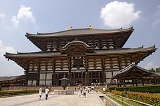
Siege of Nara
Encyclopedia
Following the 1180 Battle of the Uji
, in which Minamoto no Yorimasa
fought a small Taira army with the help of monks from the Mii-dera
and other temples, the victorious Taira, angry at being opposed, decided to assault and burn the Miidera, before moving on to Nara. The Taira were opposed by warrior monks
from nearly every major monastery and temple in Nara. Taira no Shigehira
and Tomomori
, both sons of Kiyomori
, head of the clan, commanded the siege.
The monks dug ditches in the roads, and build many forms of improvised defenses. They fought primarily with bow & arrow, and naginata
, while the Taira were on horseback, giving them a great advantage. Despite the monks' superior numbers, and their strategic defenses, their enemy succeeded in destroying nearly every temple in the city, including the Kōfuku-ji
and Tōdai-ji
. Only the Enryaku-ji
managed to repel the attackers and survive.
The 'Heike Monogatari' laments the destruction the Tōdai-ji's Daibutsu (Great Buddha statue):
In all, 3,500 people died in the burning of Nara.
Battle of Uji (1180)
The first battle of Uji is famous and important for having opened the Genpei War.In early 1180, Prince Mochihito, the Minamoto Clan's favored claimant to the Imperial Throne, was chased by Taira forces to the Mii-dera, a temple just outside Kyoto....
, in which Minamoto no Yorimasa
Minamoto no Yorimasa
' was a prominent Japanese poet whose works appeared in various anthologies. He served eight different emperors in his long career, holding posts such as hyōgo no kami...
fought a small Taira army with the help of monks from the Mii-dera
Mii-dera
', formally called ', is a Buddhist temple located at the foot of Mount Hiei, in the city of Ōtsu, in Shiga Prefecture. It is only a short distance from both Kyoto, and Lake Biwa, Japan's largest lake. The head temple of the Tendai Jimon sect, it is something of a sister temple to Enryakuji, at...
and other temples, the victorious Taira, angry at being opposed, decided to assault and burn the Miidera, before moving on to Nara. The Taira were opposed by warrior monks
Sohei
were Buddhist warrior monks of feudal Japan. At certain points of history they held considerable power, obliging the imperial and military governments to collaborate....
from nearly every major monastery and temple in Nara. Taira no Shigehira
Taira no Shigehira
' was one of the sons of Taira no Kiyomori, and one of the Taira Clan's chief commanders during the Heian period of the 12th century of Japan...
and Tomomori
Taira no Tomomori
' was the son of Taira no Kiyomori, and one of the Taira Clan's chief commanders in the Genpei War at the end of the Heian period of Japanese history....
, both sons of Kiyomori
Taira no Kiyomori
was a general of the late Heian period of Japan. He established the first samurai-dominated administrative government in the history of Japan.After the death of his father Taira no Tadamori in 1153, Kiyomori assumed control of the Taira clan and ambitiously entered the political realm in which he...
, head of the clan, commanded the siege.
The monks dug ditches in the roads, and build many forms of improvised defenses. They fought primarily with bow & arrow, and naginata
Naginata
The naginata is one of several varieties of traditionally made Japanese blades in the form of a pole weapon. Naginata were originally used by the samurai class in feudal Japan, and naginata were also used by ashigaru and sōhei .-Description:A naginata consists of a wooden shaft with a curved...
, while the Taira were on horseback, giving them a great advantage. Despite the monks' superior numbers, and their strategic defenses, their enemy succeeded in destroying nearly every temple in the city, including the Kōfuku-ji
Kofuku-ji
is a Buddhist temple in the city of Nara, Nara Prefecture, Japan. The temple is the national headquarters of the Hossō school and is one of the eight Historic Monuments of Ancient Nara inscribed on the UNESCO World Heritage List.-History:...
and Tōdai-ji
Todai-ji
, is a Buddhist temple complex located in the city of Nara, Japan. Its Great Buddha Hall , the largest wooden building in the world, houses the world's largest bronze statue of the Buddha Vairocana, known in Japanese simply as Daibutsu . The temple also serves as the Japanese headquarters of the ...
. Only the Enryaku-ji
Enryaku-ji
thumb|300px|Konpon Chū-dō , Enryaku-ji's main hall is a Tendai monastery located on Mount Hiei in Ōtsu, overlooking Kyoto. It was founded during the early Heian period. The temple complex was established by Saichō , also known as Dengyō Daishi, who introduced the Tendai sect of Mahayana Buddhism...
managed to repel the attackers and survive.
The 'Heike Monogatari' laments the destruction the Tōdai-ji's Daibutsu (Great Buddha statue):
In all, 3,500 people died in the burning of Nara.

